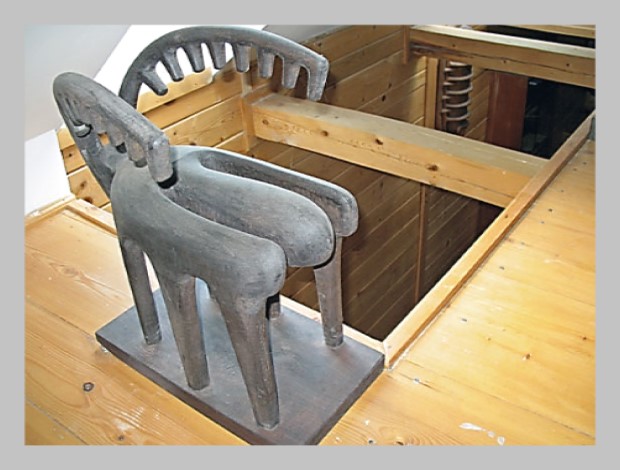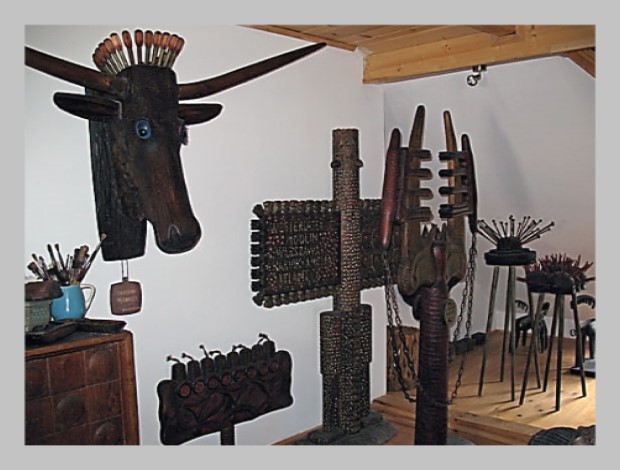
Photo Courtesy Trude Schwab

Photo Courtesy Trude Schwab
Władysław Borzęcki was born in Sromowce Niżne, Poland, on February 29, 1920. As a young man, he was a member of the local branch of Związek Strzelecki [Riflemen's Association], at that time the most important patriotic organization for young people. In 1939 he volunteered to join the Polish Army but was not mobilized. After the war, following the advice of Professor Józef Różyski – a distinguished lecturer, sculptor and architect, also a postwar expatriate from Lviv to Zakopane and later Cracow, who tirelessly roamed the villages of the highlands in Southern Poland in search of gifted youth – Władysław moved to Zakopane, where in 1950 he graduated from the famous School of Wood Processing Industry, subsequently reorganized into the Antoni Kenar High School of Fine Arts. In the years 1950 – 1955 he studied sculpture at the Academy of Fine Arts in Cracow, graduating in 1955 under the supervision of Professor Jerzy Bandura.
At the Academy of Fine Arts in Cracow, Władysław studied with such artists as Bronisław Chromy. Among his professors was Jonasz Stern (a painter and Holocaust survivor). After graduating from the Academy, he returned to Zakopane where he belonged to the local branch of Związek Polskich Artystów Plastyków [The Association of Polish Artists and Designers; Polish abbrev. ZPAP] and regularly participated in exhibitions organized by Biuro Wystaw Artystycznych [Bureau of Artistic Exhibitions; Polish abbrev. BWA], the oldest gallery in Poland. Known as ‘Borzęcki from Zakopane’, he often collaborated with his sculptor friends Bronisław Chromy and Henryk Burzec on artistic projects, mainly sacral art, in various regions of Poland.
For the first few years after graduating from the Academy of Fine Arts, Władysław Borzęcki worked mostly in plaster and mixed media. In 1962 the artist participated in a study visit to Paris. After returning home, he continued to work in plaster for a while but gradually shifted his attention to a different raw material, wood, which remained his sole medium of artistic creation from the seventies until his death on July 14, 1998.
Władysław Borzęcki was a nature lover with great respect and appreciation for the environment, and his devotion to the mountains – the Tatras and the Pieniny – was lifelong. He lived and worked in Zakopane at the foot of the Tatras, and later bought a house in his native village of Sromowce Niżne (at the foot of the Pieniny Mountains), where he set up his art studio. He commuted to Sromowce Niżne on a regular basis and continued working at his art studio, creating many elaborate sculptures in wood, including the figure of Christ for the altar of the local church, the stations of the Cross, and a bass relief of the Virgin Mary. Other works created at the studio include sculptures belonging to the Existences series, Nativity series, and Pieniny Mountains Flowers, all inspired by nature; for instance, the inspiration for the Existences series came from looking at pictures of microbes while the local flora inspired the Pieniny Mountains Flowers series. Not only did the artist draw his inspiration from nature but he also, very skillfully, incorporated the wood's texture into his carvings. As Łukasz Gazur noticed in his essay about the artist:
"Borzęcki never forced his will and chisel against the patterns inherent in the wood. He would think ‘in terms of the wood’. And extract out of it what was most characteristic. His compositions would make use of all the knots and coarseness inherent in the raw wood. He allowed them to address the onlooker directly. As if the plant grew out of nature itself, and yet was presented with superb precision."
(Excerpt from Łukasz Gazur's essay about the artist included in WŁADYSŁAW BORZĘCKI - Artist who heard the call of wood, Bernardinum, Pelplin 2019, p. 19. English translation-Olga and Wojciech Kubińscy.)


Władysław Borzęcki participated in numerous exhibitions. Many of his sculptures are displayed in churches in southern Poland. His carvings have also been purchased by museums, like Muzeum Tatrzańskie [Museum of the Tatras] in Zakopane, as well as individual collectors and are exhibited in private galleries and collections around the world:
For 38 years, he was married to Alicja. He instructed his wife in the art of carving and introduced his daughters to the foundations of fine arts.